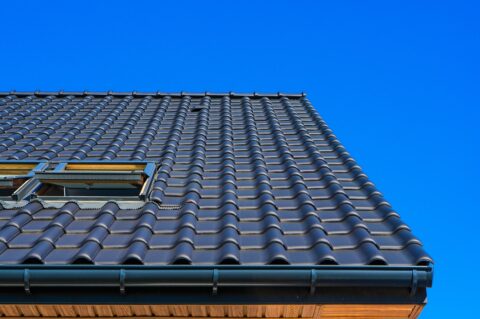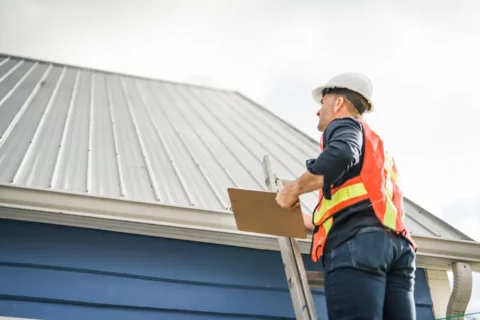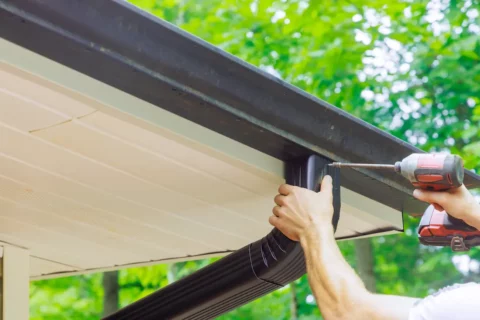
How many layers of shingles can you put on a roof in Colorado?
When it comes to roofing in Colorado, homeowners often wonder how many layers of shingles they can put on their roof. While adding another layer of shingles may seem like a cost-effective way to repair a roof, there are important factors to consider. Colorado’s unique climate, with its heavy snowfall, strong winds, and intense UV exposure, can significantly impact the performance and lifespan of a roof with multiple layers of shingles. Additionally, local building codes and regulations play a crucial role in determining the number of layers allowed.
In this blog post, we’ll explore the rules and best practices for layering shingles on your roof in Colorado. From structural concerns to energy efficiency, we’ll guide you through what you need to know before deciding whether to add another layer or opt for a complete roof replacement. Understanding the risks and benefits can help you make an informed decision that ensures your roof remains durable, safe, and compliant with local laws. Keep reading to learn how many layers of shingles are permitted and what factors to consider for long-term performance.
Building Codes and Regulations in Colorado
In Colorado, building codes and regulations are key factors in determining how many layers of shingles you can legally add to your roof. Most municipalities in the state follow the International Residential Code (IRC), which typically limits the number of shingle layers to two. This regulation is in place to ensure that roofs can handle the additional weight of multiple layers without compromising the structural integrity of the home.
Exceeding this two-layer limit can result in violations of local building codes, potentially leading to fines or issues when selling your home. In some cases, your roof may need to be fully stripped and replaced rather than adding another layer of shingles. Additionally, it’s important to check with your local building department, as some areas in Colorado, especially those with more extreme weather conditions, may have stricter guidelines.
Adhering to these building codes ensures that your roof is both safe and compliant with state laws. Before adding another layer of shingles, it’s essential to confirm local regulations and consult with a professional roofing contractor to ensure your roof can support the additional weight without compromising performance.
Impact of Multiple Layers on Roof Weight and Structure
Adding multiple layers of shingles to your roof can significantly increase the overall weight, which may lead to structural issues over time. Each additional layer adds more weight to the roof, which can put stress on the underlying structure, including the rafters, decking, and supporting walls. In Colorado, where heavy snowfalls are common, this added weight becomes even more of a concern. A roof that is already burdened by multiple layers of shingles may struggle to support the extra load of snow, increasing the risk of sagging or even collapse.
Moreover, older homes may not be designed to handle the weight of more than one layer of shingles. In such cases, adding a second or third layer could compromise the integrity of the roof’s structure. If the roof deck or framework is weakened by excessive weight, it could lead to costly repairs or even a complete roof replacement down the line.
Before deciding to add another layer of shingles, it’s important to consult with a roofing professional who can assess whether your roof can safely support the additional weight. Ensuring the structural integrity of your roof is critical to its long-term durability, especially in Colorado’s challenging climate.
Effect on Roof Longevity and Performance
While adding a second layer of shingles to your roof might seem like a quick fix, it can negatively affect the overall longevity and performance of your roof. Multiple layers of shingles tend to trap more heat, especially in Colorado’s sunny, high-altitude climate. This increased heat can accelerate the aging process of both the new and existing shingles, causing them to break down faster. As a result, the lifespan of the roof can be shortened, meaning you may need to replace it sooner than expected.
In addition to reduced lifespan, performance can also suffer. When you add a layer of shingles on top of the old ones, you may miss underlying issues such as leaks, cracks, or rotting in the original layer. These hidden problems can worsen over time, leading to water damage or mold growth, both of which are costly to repair.
Moreover, multiple layers make it harder for the roof to breathe properly, which can trap moisture between the layers, further damaging the shingles and the roof deck. For long-term performance and durability, it’s often better to remove the old shingles and start fresh rather than layering new shingles on top. This ensures a healthier, longer-lasting roof, particularly in Colorado’s demanding climate.
For more insights, check out our article on What Color of Asphalt Shingles Last the Longest in Colorado.
Energy Efficiency Considerations
The number of layers of shingles on your roof can also impact your home’s energy efficiency. In Colorado, where summers can be hot and winters can be cold, energy efficiency is a crucial consideration for homeowners. Multiple layers of shingles tend to trap more heat, especially in the summer months, which can cause your home to absorb and retain more heat than necessary. This makes it harder for your cooling system to maintain a comfortable indoor temperature, potentially increasing your energy bills.
Additionally, extra layers of shingles can reduce the roof’s ability to breathe and properly ventilate, leading to poor air circulation and increased heat retention. Without proper ventilation, the heat buildup under multiple layers of shingles can cause the attic to become much hotter, making your home less energy-efficient overall. This trapped heat can also put extra strain on your HVAC system during the summer months, further driving up energy costs.
By opting for a single, well-installed layer of shingles, you allow your roof to function more efficiently, with better heat reflection and ventilation. This can help reduce your energy consumption and lower your utility bills, especially in Colorado’s climate, where the extremes of heat and cold are common throughout the year.
Learn more about how roof color affects energy efficiency in our article on How Roof Color Affects Energy Efficiency in Colorado.
Potential Risks of Multiple Shingle Layers
While adding multiple layers of shingles might seem like a cost-saving solution, it comes with several potential risks that could compromise your roof’s overall integrity and safety. One of the primary concerns is the increased likelihood of hidden damage. When you cover an existing layer of shingles, it becomes difficult to detect underlying issues like leaks, rotting wood, or damaged underlayment. Over time, these problems can worsen, leading to costly repairs or even premature roof failure.
Another significant risk is poor moisture management. With additional layers, moisture can become trapped between the layers of shingles, creating an environment for mold and mildew growth. This trapped moisture can also weaken the roof decking, making it more susceptible to warping and structural damage.
In Colorado, where extreme weather conditions are common, multiple layers of shingles can also affect how well your roof performs during heavy snowfalls or high winds. The additional weight from multiple layers, combined with snow buildup, can increase the strain on your roof, potentially causing it to sag or collapse.
Given these risks, it’s often a safer and more effective choice to remove the old shingles and start fresh, ensuring your roof remains structurally sound and capable of withstanding Colorado’s challenging climate.
When to Consider a Complete Roof Replacement
In many cases, adding another layer of shingles to your roof may not be the best solution, and a complete roof replacement should be considered. This is particularly true in Colorado, where the weather is harsh and unpredictable. If your roof already has two layers of shingles, local building codes typically prohibit adding a third layer due to safety and structural concerns. A full replacement is often the only way to ensure your roof remains compliant with these regulations.
A complete roof replacement is also necessary if the existing shingles are severely damaged or if there are underlying issues such as leaks, rotting, or compromised decking. Adding a new layer on top of these problems won’t address the root cause and could lead to more serious damage over time, costing more in repairs down the line. Replacing the roof entirely allows you to inspect and repair any structural issues, ensuring the roof’s long-term durability.
In Colorado’s climate, with its heavy snow, intense sunlight, and temperature fluctuations, a full roof replacement can provide better protection and performance compared to layering shingles. By starting fresh, you can choose materials and designs that are more energy-efficient and better suited for Colorado’s unique weather conditions.
Check out our article on Type of Roof Adds the Most Value to a Home in Denver, Colorado for more guidance on roofing materials in Colorado.
Conclusion
Deciding whether to add another layer of shingles or opt for a full roof replacement is a significant decision, especially in Colorado’s demanding climate. While layering shingles may seem like a quick and cost-effective fix, the potential risks to your roof’s structural integrity, energy efficiency, and longevity should not be overlooked. A thorough evaluation of your roof’s condition is essential to ensure it can withstand Colorado’s heavy snowfalls, intense sunlight, and fluctuating temperatures.
At 303 Roofer, we understand the complexities of roofing in Colorado and are here to help you make the best decision for your home. Our experienced professionals will assess your roof’s condition, discuss your options, and provide expert recommendations tailored to your specific needs. Whether you’re considering a new layer of shingles or a complete roof replacement, we’re committed to delivering quality solutions that ensure your roof’s durability and performance.
Contact us today for a free consultation and roof evaluation. Let us help you make an informed choice that will protect your home, save on energy costs, and add value for years to come. We look forward to assisting you with all your roofing needs.



